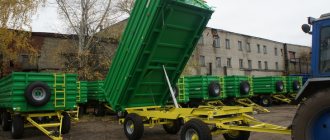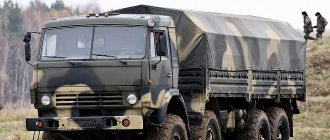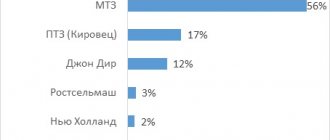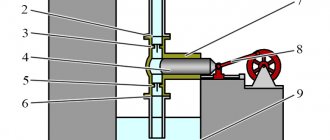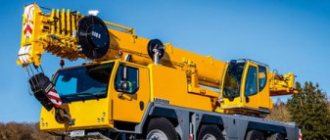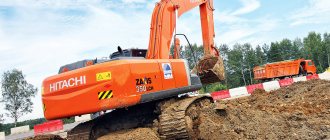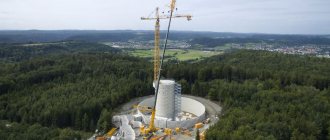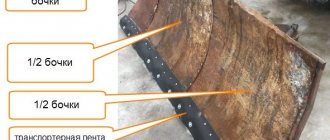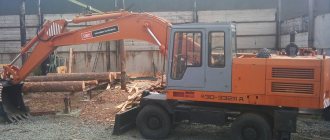An excavator is a special piece of equipment equipped with a bucket, which is designed for digging, loading and mining. The scope of application depends on the type of excavator buckets. There are more than ten types of them, which differ in design and are also equipped with removable elements that protect against wear.
Description of excavator bucket
The shape of an excavator bucket is a bowl with a cutting edge or teeth. It is used on construction sites for digging pits, mining, sifting rocks, and in public utilities for cleaning roads. Attachments for special equipment are wear-resistant, operate under large temperature differences, with hard mineral and abrasive rocks.
The standard working body of special equipment is made of high-quality low-alloy steel grades 09G2S, 10HSND with the addition of chromium, nickel and molybdenum. The top of the metal is treated with powder paints for additional protection against corrosion.
By design, the types of buckets are:
- cast;
- welded;
- combined.
To perform complex work, they are equipped with lifting hooks, sieves, crushers and other elements.
Excavator bucket equipment:
- cutting edge
; - side cutters, protectors
; - crowns
; - between tooth protection
; - lining;
- The heels are the corner parts.
To protect the excavator bucket, a lining is used - these are steel strips with a density greater than HB500 welded at the bottom and top of the bottom and heel, protecting the corner welds of the sidewall and bottom. Tiles, heels and buttons (HB700, 1000) are a special lining that is attached to the backing and withstands severe abrasion, but crumbles when subjected to side impacts.
Bucket design. Materials
An excavator is a special equipment designed for loading, excavation, and mining of rocks. The working part of the equipment is made in the form of a bowl with a cutting edge or teeth.
Without a bucket, it is impossible to carry out construction work, dig ditches, mine, sift rocks, carry out communications and clear roads from snow and debris.
The structure consists of the following elements:
- wear plates, side, rear wall;
- additional plates, side brush;
- loop for lifting the bucket, adjusting washer;
- overlay cutting edges, adapters and crowns.
The design depends on the type of bucket, but the back and two side walls, which together look like a bowl, remain unchanged.
The standard ladle is made from high-strength low-alloy steel grade 0G2S or 10ChSND with alloying components in the form of chromium, nickel and molybdenum. They affect the strength characteristics of steel.
To perform complex work on rocky soils, buckets made from Hardox, Weldox and similar steel are used. These metal alloys are characterized by high hardness, high impact strength, ease of processing on cutting machines and weldability. They have a long service life.
Why use certified cutting elements?
The value of earthmoving equipment lies in its endurance and long-lasting performance. If consumables on a bucket have to be replaced too frequently, maintenance costs will increase. Downtime increases, and every hour of expensive machines results in large financial losses.
Cutting elements wear out the fastest because they are in direct contact with the ground. If crowns, teeth, side cutters are made of soft material, they are poorly fixed on the adapters, become loose and become damaged.
Manufacturers who produce only cutting elements pay close attention to quality issues. They use ultra-strong steel, hardened using special technology. They use their own patented fastening technologies, so they get high results.
Komatsu has studied the market for cutting elements in detail and selected those that are most suitable for the brand’s earthmoving equipment. They meet its design requirements, withstand intense loads and last longer than products from other lines.
Each construction equipment manufacturer will recommend the optimal consumables for their machines. In the case of Komatsu excavators, cutting elements from Hensley (USA) and KVX (Norway) are recognized as such. If the goal is to maximize the period of uninterrupted operation, crowns and protection systems of these brands are ideal for these purposes.
Cutting elements are the key to long service life of the bucket
The main requirements for cutting elements are wear resistance and the ability to quickly replace. Teeth on large machines weigh 200–400 kg, so replacing 5–8 such parts is a labor-intensive process. The simpler the fastening system is implemented, the shorter the downtime will be.
High-quality, properly selected cutting elements increase the service life of the bucket in earthmoving equipment, as they protect the edges from wear. The crowns absorb shock loads, and teeth with a special profile penetrate the soil more easily. The time required to complete the work is reduced and the productivity of the equipment increases. Thanks to the easy replacement of worn parts, the time and cost of repairs are reduced, which is especially important, because every hour of downtime is a lot of money.
Types of buckets
The characteristics of an excavator bucket depend on its type. The main options include universal, loader, ripper, reinforced and leveling models. Let's consider the features of all types of equipment.
Standard or universal
The most common type of excavator bucket. They are used on light and medium soils: black soil, sand, loam, sandy loam. And they are suitable for working with gravel, crushed stone, and limestone. The main type of work is loading and moving bulk materials. They vary in volume and load capacity.
Reinforced
The design features are completely identical to standard buckets. But they are equipped with special reinforced devices for working with heavy and rocky rocks and soil.
The maximum soil density with which the reinforced structure can work is 2500 kg/m³. These types of soil include chalk rocks, shale, and limestone.
Rippers
Buckets with stepped teeth. They are suitable for working with frozen soil. They easily cope with crushing soil into small fractions, which are easier to transport and remove from the territory.
Rippers are often used in rock crushing and stone breaking.
Loading
The models are used for loading or unloading various bulk cargoes from vehicles. Suitable for carrying sand, peat, slag and other materials. The design for loading operations is equipped with a smooth cutting edge. To reduce bucket wear, additional protective elements are installed.
Planning
The design is suitable for work on canals, embankments, river slopes and highways. The equipment allows you to create longitudinal recesses in a surface located at an angle of 40-85 °.
Leveling buckets are produced in the form of a rectangle with one or two stiffening ribs in the center and with a cutting edge. There are enhanced modifications in which a knife is added. They can be equipped with rotating mechanisms and hydraulic cylinders.
Stripping
Special buckets required for working on reservoirs. They are needed to clean the bottom. Welded, lightweight construction. It is equipped with a sharp edge and movable teeth. There is additional perforation on the walls and bottom.
Rocky
Special models for working in difficult conditions with very hard soils: granite, basalt and others. Made only from wear-resistant steel. The design itself is equipped with reinforced side plates and teeth with planes between them. To increase the service life, the cheeks and bottom of the structure are covered with welded protection. Can be equipped with side cutters.
Profile
Special models required for digging trenches with slopes located at certain angles or vertically. They are used to create channels, ditches and ditches. The design is made in the form of a trapezoid. The knives are located outside the boundaries of the bucket.
The bottom of profile models has a constant width, but the slope of the walls can be adjusted. This is necessary for excavating soil and forming the side walls of the ditch at the desired slope. After such treatment, the soil does not crumble into the ditch.
Profile options can work with soil whose density is up to 2000 kg/m³.
Trench
Needed for digging narrow trenches in the shape of a rectangle. They are needed for laying pipelines and underground laying of electrical cables. Buckets work with any type of soil. Capable of digging trenches in hard-to-reach places.
The design is small in width (from 30 to 65 cm) and light in weight. The walls are movable, so the contact area between them and the soil is minimal. During operation, the soil practically does not stick to the structure.
Lattice
Suitable for sifting rocks and materials with their further loading into vehicles. Equipped with perforation. They have cutting organs in the form of a sharp edge and teeth.
Skeletal or lattice models are needed only for separating stones into specified sizes and loading them into a vehicle.
Forward and reverse shovels
The difference between a straight shovel and a backhoe is the digging method. Direct – special equipment moves away from itself, working with the ground located above the plane of the equipment’s support. Reverse - self-propulsion, suitable for sites located below the level of the excavator.
Trapezoidal
The trapezoidal design is suitable for construction and installation work. It is capable of digging a trench with inclined walls. They vary in volume and size.
Grab
We need buckets for digging soil from the depths; they are suitable for digging pits for the construction of multi-storey residential buildings. The design consists of two parts that capture the soil and transport it in a closed state to the dump site and trucks.
How to choose the right one
To choose the right product, you need to know the exact name and model of the special equipment, as well as the type of fastening. You need to choose only among those buckets that are compatible with the equipment. You need to choose based on your goals and budget. If your goals have not yet been determined, you can choose universal equipment. Which is suitable for solving most problems that require special equipment with a bucket.
The selection must be carried out by specialists from the manufacturer. When choosing, you need to pay attention to the dimensions of the product, as well as the material used. The bucket must strictly comply with the required parameters in terms of size and weight.
Choosing a bucket depending on the soil
Based on the type of soil that an excavator bucket can work with, there are three subgroups:
- Standard. Works with a variety of soils including clay, gravel and sand. They are made from high-quality wear-resistant steel grade 09G2Sb 10HSND with a hardness rating of HB200-250.
- Reinforced. They are necessary for working with abrasive materials in difficult conditions for earthworks. Models are produced from wear-resistant steel with additional welded protection - linings made of Hardox steel and similar ones.
- Rocky. Special buckets for working with rock and hard rocks. They have inter-tooth protection, a thickened bottom, and protected linings on the cheeks and side walls. All auxiliary elements affect the service life of the equipment.
In urban conditions, at ordinary construction sites, excavators with standard buckets of different subtypes are most often found. Reinforced and rock options are used only for certain types of work.
Bucket modifications from John Deere
- Jonh Deere 315. Universal attachment, which is designed to perform most general ground activities. The size of the excavator bucket greatly simplifies soil unloading and is perfect for working with clay soils.
- Jonh Deere 325. A highly efficient unit for working with both fine, soft and hard soil. A distinctive feature is that the teeth have a bolted fastening system, that is, they can subsequently be replaced with new ones, which makes the unit indispensable.
- Jonh Deere 710. Highly efficient accessory with the best excavator bucket capacity. Indispensable for performing a whole range of land management and construction operations. You can significantly speed up production work on site.
All presented models from Jonh Deere have impeccable technical and operational performance. Compatible with many types of modern technology.
Where is the best place to buy attachments?
Our company presents a huge assortment of various parts for attachments installed on equipment that is used in road repair, and for digging trenches, and for the construction of high-rise buildings, and in working with cleaning companies.
The buckets presented on our website are distinguished by their versatility; they can be used to perform huge volumes of work. You can ask our managers questions about purchasing buckets by calling the phone number listed on the website.
